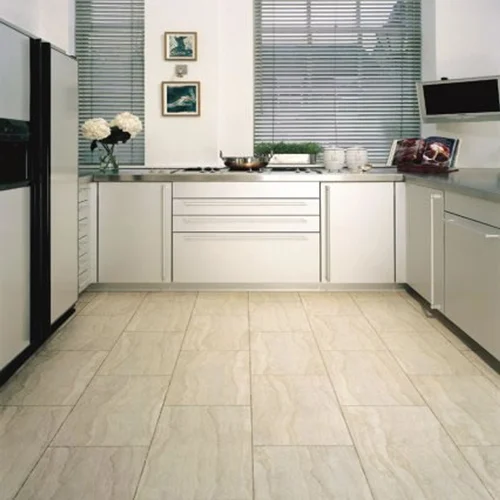Tile is durable and hard-wearing, making it the ideal material for heavily trafficked kitchen floors. Plus, its wide array of colors and textures offers infinite design opportunities.
Large tiles create the illusion that kitchens of any size are larger, hiding any subfloor imperfections and adding visual interest to the space. Leanne Ford Interiors of Leanne Ford Interiors designed a lodge-style kitchen using textured slate floor tiles for visual interest in this lodge-style kitchen design.
Black Tiles
Black tiles can add drama and sophistication to kitchen designs that range from modern or rustic. When coupled with white tile or natural stone flooring, their striking contrast stands out. Selecting a tile style and finish that best matches this trend is key.
Checkerboard patterns mixed with white or other colored tiles look timeless and never go out of style. A herringbone pattern adds modernity, or for something truly distinctive try a vertical stacked tile layout.
If you want your black tiles to stand out, take a cue from Beth Haley Design and opt for geometrical shapes as your tile pattern – they will add visual interest without competing with the ebony floor!
Patterned Tiles
Patterned tiles add visual interest and durability to the kitchen while being easy-to-clean surfaces. There is an assortment of patterned options, ranging from basic striped floor tiles to intricate mosaic patterns – with porcelain being one of the more commonly used materials for such tiles.
Blogger Ursula Carmona used glazed porcelain wood-look tiles to create an eye-catching, low maintenance floor in her home kitchen. The bold pattern defines the space while complementing the concrete skim coat on the walls.
Combining patterned tiles with solid-colored ones is possible, but to do it effectively requires striking a balance in terms of color scheme. Too many patterns can make a space seem overcrowded; use patterned tiles sparingly to add visual interest and give your kitchen some visual depth.
Wood-Look Tiles
Wood-look tile brings nature indoors with beautiful options that emulate natural wood grain, from airy gray planks to heavily textured porcelain tiles with wood grain textures that mimic nature. Plus, these floors are durable and pet-friendly!
Real wood must be regularly resanded and painted; unlike these tiles, which can be colored using stain. Plus, they better resist moisture damage than its wood counterpart, so there won’t be as many warped or buckled pieces over time.
Manufacturers employ high-resolution printing processes on porcelain tiles to produce realistic wood-look tiles with realistic features such as chipped edges, saw marks and other imperfections to complete the illusion of wood graining.
Natural Stone Tiles
Natural stone tiles bring sophistication to any kitchen, are durable, and come in various colors to complement any design scheme. Our Leicester Flooring showroom staff can assist in selecting beautiful natural stone tiles for either the backsplash or floor space of your kitchen.
Natural stone tiles typically come with either a polished or honed and matte finish to provide a sleek, shiny surface, but honed or matte can also be beautiful options that make maintenance easier. When selecting polished tiles, they must be sealed regularly because natural stone contains pores which absorb stains or other liquids that may seep through.
Tile-Looking Concrete
Concrete-look tile adds an industrial feel to kitchens while remaining more durable than real concrete and available in various sizes to fit all kinds of floor designs.
Geometric shapes like hexagons, diamonds, and octagons add eye-catching style to kitchen floors. Large-format styles can reduce grout lines while classic subway tiles provide timeless charm.
Encaustic-look porcelain tiles bring a distinctive aesthetic to kitchens. Their adaptable designs can be enhanced with more robust decor accents or left alone for an unforgettable design statement.
Glazed Porcelain Tiles
Glazed porcelain tiles can imitate nearly any material or style. Manufacturers employ inkjet printing technology to produce intricate designs that resemble natural stones, timbers, terrazzo floors or any pictorial images.
Their manufacturing process makes porcelain tiles more water-resistant than ceramic ones, with moisture absorption rates below 0.5% making them suitable for wet environments such as kitchen floors.
Glazed porcelain tiles come in an extensive palette of hues to make a statement with your kitchen flooring. Matte finishes offer subtlety for Scandinavian or minimalist styles that prioritize clean lines.





